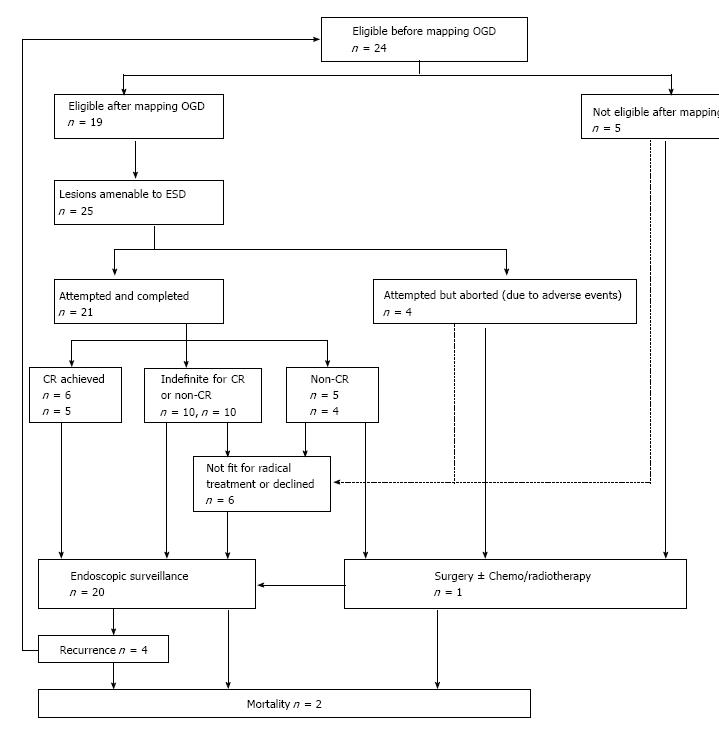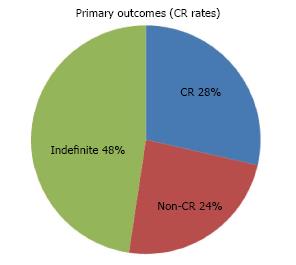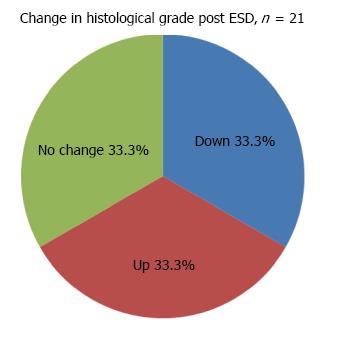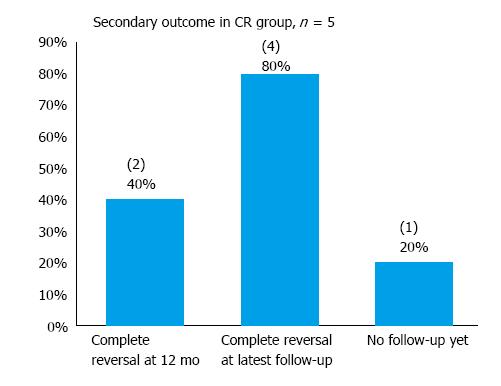Copyright
©The Author(s) 2017.
World J Gastrointest Endosc. Dec 16, 2017; 9(12): 561-570
Published online Dec 16, 2017. doi: 10.4253/wjge.v9.i12.561
Published online Dec 16, 2017. doi: 10.4253/wjge.v9.i12.561
Figure 1 Prisma diagram showing how patients have been selected and their respective outcomes.
CR: Curative resection.
Figure 2 Endoscopic appearance of the gastric lesions considered for resection with endoscopic submucosal dissection.
A-E: Macroscopic appearance of lesion with mapping OGD and thus suitable for ESD. This is an area extending from the antrum through to the pyloric ring. The ESD procedure is highlighted here; F: Macroscopic appearance of lesion with suspected sm3 or deeper on mapping OGD and thus unsuitable for ESD. This is an area extending from the cardia through to the upper body. ESD: Endoscopic submucosal dissection.
Figure 3 Pie chart showing the rate of primary outcomes: CR (6), non-CR (5) or indefinite (10) when data is inadequate to definitively qualify a resection as CR or non-CR.
CR: Curative resection; Non-CR: Non-curative resection.
Figure 4 The appearance of the stomach wall on endoscopic follow-up of the patient in which endoscopic submucosal dissection had to be aborted twice due to profuse bleeding.
The patient had a high INR and was a poor candidate for ESD at baseline but co-morbidities precluded surgery in his case. Note the 2 metachronous malignant sessile polyps Paris 2a and the marked mucosal friability evident from bleeding. ESD: Endoscopic submucosal dissection.
Figure 5 Pie chart showing how endoscopic submucosal dissection changed the histological grade of the resected lesions.
Down: Downstaged; Up: Upstaged; ESD: Endoscopic submucosal dissection.
Figure 6 Column chart showing the difference between pre-ESD and post-ESD histological grade for all 16 resected lesions.
LGD: Low grade dysplasia; HGD: High grade dysplasia; IMC: Intramucosal carcinoma; LV: Lympho-vascular invasion; ESD: Endoscopic submucosal dissection.
Figure 7 Column chart showing secondary outcomes i.
e. complete reversal of dysplasia at 12 mo endoscopic follow-up and/or at latest follow-up in the group indefinite for curative resection or non-curative resection post endoscopic submucosal dissection. CR: Curative resection.
Figure 8 Column chart showing secondary outcomes i.
e. complete reversal of dysplasia at 12 mo endoscopic follow-up and/or at latest follow-up in the group curative resection post endoscopic submucosal dissection. CR: Curative resection.
- Citation: Sooltangos A, Davenport M, McGrath S, Vickers J, Senapati S, Akhtar K, George R, Ang Y. Gastric endoscopic submucosal dissection as a treatment for early neoplasia and for accurate staging of early cancers in a United Kingdom Caucasian population. World J Gastrointest Endosc 2017; 9(12): 561-570
- URL: https://www.wjgnet.com/1948-5190/full/v9/i12/561.htm
- DOI: https://dx.doi.org/10.4253/wjge.v9.i12.561
















